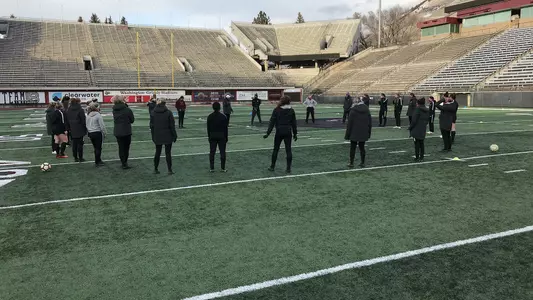
Griz embark upon unusual season
1/27/2021 7:52:00 PM | Soccer
The sky was gray, both cold and lifeless, and the wind was whipping through Hellgate Canyon on Wednesday afternoon as the Montana soccer team made its way into Washington-Grizzly Stadium for its first practice of the most unusual season any of the Grizzlies will have ever played.
It's a team that typically opens its season in the first days of August, when the top concerns are sunscreen and proper hydration. The grass is lush, the sky is almost always a brilliant blue and teeming with life, from birds to the occasional paraglider landing next to Montana's true home field.
The coldest days, not like Wednesday but chilly enough that you know days like Wednesday are soon to be arriving, come later in the season, in early November, when the games mean the most. As the temperature drops, the tension rises.
It's what 11-and-a-half months of the year are building toward. The Big Sky Conference tournament. Hopefully the NCAA tournament. It's a cycle that's repeated itself, at least for the Montana soccer program, every autumn since 1994.
The new season, one everyone hopes will be a one-off? It will start in parkas and on artificial turf. Wind chills will need to be monitored. At some point, piles of snow around the perimeter of the field will need to be taken into consideration.
"It is what it is," said Taylor Hansen, Montana's first-team All-Big Sky Conference defender. "It's become my favorite saying. We're going to go out and do us no matter what. We move on, roll with the punches. Just put a smile on your face and have fun."
It's a team that couldn't wait for the new season a year ago. The Grizzlies had won the 2019 Big Sky regular-season title by going unbeaten through league at 6-0-3, with just two goals allowed.
But in the Big Sky semifinals, top-seeded Montana fell to Northern Colorado on the Bears' home field in Greeley, 2-1 in overtime. The game-winning goal landed with the force of Thor's hammer. The team that couldn't be beaten had just been defeated. The season was over, and it wasn't supposed to end like that.
They anticipated getting their usual spring, then a summer, then a fall season when the Grizzlies would make things right. They would finish what they set out to do.
"Something was off. I don't know what it was," said Hansen of Montana's tournament loss to Northern Colorado. "It's how we played that day. We're looking to get better now."
If the Grizzlies do get better, that might be trouble for the rest of the Big Sky, considering Montana, with no starters lost and 18 letter-winners back from that championship team, was picked atop the preseason coaches' poll, the one that came out in July, when a fall season was still a possibility.
They also have that little something to warm the frostiest of practices, something they've been carrying with them for more than a year. Call it baggage, something they'd like to return to those Bears should they be gifted the chance. "They've got something coming for them," said Hansen.
Keeping all those elements -- vengeance blended with wrath, all wrapped in potential -- together and under control is third-year coach Chris Citowicki, who led Montana to a tournament title in his first season, a regular-season championship in his second.
He typically has less than three weeks from the opening day of practice until his team's first match in mid-August. Unless Citowicki can add something to Montana's schedule in late February or early March, this team won't play its first match until six weeks from Friday, when the Grizzlies play at Idaho.
It becomes a balance of both tempering and training. The games will come quickly once they arrive, but six weeks in winter, of too much repetition in too dispiriting of an environment, could make anyone go Jack Torrance. All work and no play, right?
"This is still July right now, when we're getting ready and laying a base. We don't need to rush anything or do more," Citowicki said of his soft entry into the season.
"We've laid it out so (the players') brains can be like, Okay, this is what the process is like. We're trying to replicate the fall in the spring. The 1st of February is when we'll start a preseason that is going to take us into an exhibition game or scrimmage, if we can figure that out, then we go into a game phase."
To suit the times, the Big Sky will use two divisions for its spring schedule, with Montana joining Eastern Washington, Idaho, Portland State and Sacramento State in the Northwest Division.
The Grizzlies will play two-match series against the other four teams, with both matches against an opponent at the same location.
Montana will host Portland State and Eastern Washington, and make trips to Idaho and Sacramento State.
"It's great. It's exciting. That's what we needed for the spring, something with a little twist on it. It's a good different," said Citowicki.
The top two teams in each division will then make their way to Ogden, Utah, in mid-April for a four-team Big Sky tournament.
According to the polls, which have Montana at No. 1, Eastern Washington at No. 3 and Sacramento State at No. 4, each of them worthy of first-place votes, someone from the Northwest Division is going to be left without a chair when the music stops.
"A pretty good team is not going to make the playoffs, so the whole thing becomes a tournament," said Citowicki. "Every game will matter, especially when you have to collect points right away."
When the fall season was first postponed, then canceled with an eye on playing in the spring, Citowicki faced a dilemma.
Push them hard all fall and hope they don't burn out? Minimize soccer so the players can focus on and deal with the other, more pressing, stresses in their lives?
Between those extremes, Citowicki landed on middle ground. Montana practiced but not as much as it could have. Yet more than some programs. After all, these were athletes in his care, and they wanted to be athletes, to feel like at least something in their lives was normal.
Most important, the Grizzlies came together with purpose. "The approach was, if we have time to practice, let's use it to actually get better at something," he said.
Hired in May 2018, Citowicki inherited a dominant defensive team, headlined by goalkeeper Claire Howard, and that hasn't stopped. In two years under the coach, Montana has allowed 41 goals in 41 matches played.
And yet Citowicki enters his third year with a sub-.500 record of 14-15-12, mainly because his teams have scored just 33 goals in those 41 matches. Thirty-two of those 41 matches have been draws or decided by a single goal. In other words, the margin for error has been razor thin.
But what if he could take that extra time allotted him in the fall and address that lack of goal-scoring punch? What if he could keep what his team has in the back and, say, start scoring two or more goals every time out?
Those teams don't go to Greeley and lose in the semifinals. They win championships. They become the hammer.
"That was the main focus. How can we become better in the way we attack so that we can score more goals while also maintaining that stability that we already have in the back? That was the challenge for the whole fall," he said.
"We've needed a better attacking identity, and that takes time to develop." And time was what he and his players had. "The point was to get to the end of fall and know we're better at something, something that can be plugged right back in in the winter and here we go again."
Howard, who owns a miniscule goals-against average of 0.87 for her career, enters the spring with 26 career shutouts. That leaves her just three from tying the Big Sky record of 29, set by Sacramento State's Savannah Abercrombie from 2008-11.
And yet Howard has never been voted by the Big Sky coaches as higher than second-team all-league, despite being on the verge of making history.
Beyond her own talents, she has a chance to reach 30 or more shutouts because of those players working in front of her.
Caitlin Rogers was the Big Sky co-Defensive MVP in 2019. Her fellow center back, Allie Larsen, was honorable mention all-league.
On the outside she has Hansen, first-team All-Big Sky, and McKenzie Kilpatrick, a one-time Big Sky Defensive Player of the Week.
It's a modern-day Murderers' Row, a stone wall in ponytails that has kept Howard from being tested on a regular basis, which has kept her numbers down, which has been used against her in postseason voting and discussions of the Big Sky's top goalkeeper the last three seasons.
As if she is at fault for operating that back line like an expert marionette handler, calling out threats they don't always see and moving her teammates where they need to be before they realize they need to be there.
It's here that we'll mention Montana added Molly Quarry, a transfer from Nebraska, in December. She plays on the back line as well. Less than a year ago she was representing her home country of Canada at the 2020 CONCACAF Women's U-20 Championship in the Dominican Republic. So she's pretty good.
That Avery Adams is playing just ahead, at holding midfielder, makes it an embarrassment of riches on that end of the field.
Adams played two years at outside back, then moved up last season when Ali Monroe was injured. She was a natural. She kept her defensive mindset and also collected three assists as a playmaker. At season's end she collected first-team All-Big Sky honors.
Which leads us to the attack, or that which could take a strong defensive team and turn it into a well-rounded juggernaut. Because after all, over the last two regular seasons, Montana has allowed more than a single goal in a match just six times. If Montana scores twice? You do the math.
Citowicki's got everybody back who scored a goal in 2019, and last January he added Mimi Eiden, who totaled 12 goals and seven assists in three seasons at North Dakota.
And he had last fall, when he just needed more time, and time was what everyone had in excess. And they got to work.
"You need to find a system that fits the players you have," Citowicki said. "Looking at it for two years, we've played players in positions that they maybe weren't suited for. Now we've figured out a way with the players we have."
It's no longer: Let Alexa Coyle get after it and hope she scores today. If not, the defense had better come through with a shutout.
There is Eiden. And Rita Lang, who scored four times in 2019. Taylor Stoeger. Star-in-waiting Jaden Griggs. And we could go on.
"The level of competition for the forward group is just crazy," said Citowicki. "And we can cycle through that." By which he means if you exhale when Coyle subs out, you're already at a disadvantage, because someone new is coming on to run you breathless.
"You won't get a break, because somebody else is coming on who is just as hard-working, just as athletic, and now you have to deal with that."
Rock-solid in the back? An emerging threat up front? As Hansen would say, it is what it is. And it be good.
It's a team that typically opens its season in the first days of August, when the top concerns are sunscreen and proper hydration. The grass is lush, the sky is almost always a brilliant blue and teeming with life, from birds to the occasional paraglider landing next to Montana's true home field.
The coldest days, not like Wednesday but chilly enough that you know days like Wednesday are soon to be arriving, come later in the season, in early November, when the games mean the most. As the temperature drops, the tension rises.
It's what 11-and-a-half months of the year are building toward. The Big Sky Conference tournament. Hopefully the NCAA tournament. It's a cycle that's repeated itself, at least for the Montana soccer program, every autumn since 1994.
The new season, one everyone hopes will be a one-off? It will start in parkas and on artificial turf. Wind chills will need to be monitored. At some point, piles of snow around the perimeter of the field will need to be taken into consideration.
"It is what it is," said Taylor Hansen, Montana's first-team All-Big Sky Conference defender. "It's become my favorite saying. We're going to go out and do us no matter what. We move on, roll with the punches. Just put a smile on your face and have fun."
It's a team that couldn't wait for the new season a year ago. The Grizzlies had won the 2019 Big Sky regular-season title by going unbeaten through league at 6-0-3, with just two goals allowed.
But in the Big Sky semifinals, top-seeded Montana fell to Northern Colorado on the Bears' home field in Greeley, 2-1 in overtime. The game-winning goal landed with the force of Thor's hammer. The team that couldn't be beaten had just been defeated. The season was over, and it wasn't supposed to end like that.
They anticipated getting their usual spring, then a summer, then a fall season when the Grizzlies would make things right. They would finish what they set out to do.
"Something was off. I don't know what it was," said Hansen of Montana's tournament loss to Northern Colorado. "It's how we played that day. We're looking to get better now."
If the Grizzlies do get better, that might be trouble for the rest of the Big Sky, considering Montana, with no starters lost and 18 letter-winners back from that championship team, was picked atop the preseason coaches' poll, the one that came out in July, when a fall season was still a possibility.
They also have that little something to warm the frostiest of practices, something they've been carrying with them for more than a year. Call it baggage, something they'd like to return to those Bears should they be gifted the chance. "They've got something coming for them," said Hansen.
Keeping all those elements -- vengeance blended with wrath, all wrapped in potential -- together and under control is third-year coach Chris Citowicki, who led Montana to a tournament title in his first season, a regular-season championship in his second.
He typically has less than three weeks from the opening day of practice until his team's first match in mid-August. Unless Citowicki can add something to Montana's schedule in late February or early March, this team won't play its first match until six weeks from Friday, when the Grizzlies play at Idaho.
It becomes a balance of both tempering and training. The games will come quickly once they arrive, but six weeks in winter, of too much repetition in too dispiriting of an environment, could make anyone go Jack Torrance. All work and no play, right?
"This is still July right now, when we're getting ready and laying a base. We don't need to rush anything or do more," Citowicki said of his soft entry into the season.
"We've laid it out so (the players') brains can be like, Okay, this is what the process is like. We're trying to replicate the fall in the spring. The 1st of February is when we'll start a preseason that is going to take us into an exhibition game or scrimmage, if we can figure that out, then we go into a game phase."
To suit the times, the Big Sky will use two divisions for its spring schedule, with Montana joining Eastern Washington, Idaho, Portland State and Sacramento State in the Northwest Division.
The Grizzlies will play two-match series against the other four teams, with both matches against an opponent at the same location.
Montana will host Portland State and Eastern Washington, and make trips to Idaho and Sacramento State.
"It's great. It's exciting. That's what we needed for the spring, something with a little twist on it. It's a good different," said Citowicki.
The top two teams in each division will then make their way to Ogden, Utah, in mid-April for a four-team Big Sky tournament.
According to the polls, which have Montana at No. 1, Eastern Washington at No. 3 and Sacramento State at No. 4, each of them worthy of first-place votes, someone from the Northwest Division is going to be left without a chair when the music stops.
"A pretty good team is not going to make the playoffs, so the whole thing becomes a tournament," said Citowicki. "Every game will matter, especially when you have to collect points right away."
When the fall season was first postponed, then canceled with an eye on playing in the spring, Citowicki faced a dilemma.
Push them hard all fall and hope they don't burn out? Minimize soccer so the players can focus on and deal with the other, more pressing, stresses in their lives?
Between those extremes, Citowicki landed on middle ground. Montana practiced but not as much as it could have. Yet more than some programs. After all, these were athletes in his care, and they wanted to be athletes, to feel like at least something in their lives was normal.
Most important, the Grizzlies came together with purpose. "The approach was, if we have time to practice, let's use it to actually get better at something," he said.
Hired in May 2018, Citowicki inherited a dominant defensive team, headlined by goalkeeper Claire Howard, and that hasn't stopped. In two years under the coach, Montana has allowed 41 goals in 41 matches played.
And yet Citowicki enters his third year with a sub-.500 record of 14-15-12, mainly because his teams have scored just 33 goals in those 41 matches. Thirty-two of those 41 matches have been draws or decided by a single goal. In other words, the margin for error has been razor thin.
But what if he could take that extra time allotted him in the fall and address that lack of goal-scoring punch? What if he could keep what his team has in the back and, say, start scoring two or more goals every time out?
Those teams don't go to Greeley and lose in the semifinals. They win championships. They become the hammer.
"That was the main focus. How can we become better in the way we attack so that we can score more goals while also maintaining that stability that we already have in the back? That was the challenge for the whole fall," he said.
"We've needed a better attacking identity, and that takes time to develop." And time was what he and his players had. "The point was to get to the end of fall and know we're better at something, something that can be plugged right back in in the winter and here we go again."
Howard, who owns a miniscule goals-against average of 0.87 for her career, enters the spring with 26 career shutouts. That leaves her just three from tying the Big Sky record of 29, set by Sacramento State's Savannah Abercrombie from 2008-11.
And yet Howard has never been voted by the Big Sky coaches as higher than second-team all-league, despite being on the verge of making history.
Beyond her own talents, she has a chance to reach 30 or more shutouts because of those players working in front of her.
Caitlin Rogers was the Big Sky co-Defensive MVP in 2019. Her fellow center back, Allie Larsen, was honorable mention all-league.
On the outside she has Hansen, first-team All-Big Sky, and McKenzie Kilpatrick, a one-time Big Sky Defensive Player of the Week.
It's a modern-day Murderers' Row, a stone wall in ponytails that has kept Howard from being tested on a regular basis, which has kept her numbers down, which has been used against her in postseason voting and discussions of the Big Sky's top goalkeeper the last three seasons.
As if she is at fault for operating that back line like an expert marionette handler, calling out threats they don't always see and moving her teammates where they need to be before they realize they need to be there.
It's here that we'll mention Montana added Molly Quarry, a transfer from Nebraska, in December. She plays on the back line as well. Less than a year ago she was representing her home country of Canada at the 2020 CONCACAF Women's U-20 Championship in the Dominican Republic. So she's pretty good.
That Avery Adams is playing just ahead, at holding midfielder, makes it an embarrassment of riches on that end of the field.
Adams played two years at outside back, then moved up last season when Ali Monroe was injured. She was a natural. She kept her defensive mindset and also collected three assists as a playmaker. At season's end she collected first-team All-Big Sky honors.
Which leads us to the attack, or that which could take a strong defensive team and turn it into a well-rounded juggernaut. Because after all, over the last two regular seasons, Montana has allowed more than a single goal in a match just six times. If Montana scores twice? You do the math.
Citowicki's got everybody back who scored a goal in 2019, and last January he added Mimi Eiden, who totaled 12 goals and seven assists in three seasons at North Dakota.
And he had last fall, when he just needed more time, and time was what everyone had in excess. And they got to work.
"You need to find a system that fits the players you have," Citowicki said. "Looking at it for two years, we've played players in positions that they maybe weren't suited for. Now we've figured out a way with the players we have."
It's no longer: Let Alexa Coyle get after it and hope she scores today. If not, the defense had better come through with a shutout.
There is Eiden. And Rita Lang, who scored four times in 2019. Taylor Stoeger. Star-in-waiting Jaden Griggs. And we could go on.
"The level of competition for the forward group is just crazy," said Citowicki. "And we can cycle through that." By which he means if you exhale when Coyle subs out, you're already at a disadvantage, because someone new is coming on to run you breathless.
"You won't get a break, because somebody else is coming on who is just as hard-working, just as athletic, and now you have to deal with that."
Rock-solid in the back? An emerging threat up front? As Hansen would say, it is what it is. And it be good.
Players Mentioned
Griz Football Weekly Press Conference - 10/13/25
Tuesday, October 28
Griz Volleyball vs. Weber State Postgame Report - 10/25/25
Tuesday, October 28
Griz Volleyball vs. Idaho State Postgame Report - 10/23/25
Tuesday, October 28
Griz Football Weekly Press Conference - 10/20/25
Tuesday, October 28




















